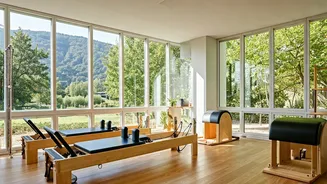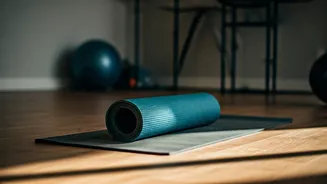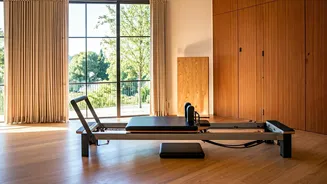Pilates Fundamentals Explained
Pilates, a system of exercises focusing on controlled movements, has gained immense popularity for its ability to enhance core strength, flexibility, and
body awareness. Developed by Joseph Pilates, this exercise regimen emphasizes precision, breath control, and proper alignment. The core is the primary focus, with each exercise designed to engage and strengthen the abdominal muscles, lower back, and pelvic floor. Beyond physical benefits, Pilates cultivates mental focus and body awareness, teaching individuals to move with intention and efficiency. Unlike high-impact exercises, Pilates is gentle on the joints, making it suitable for individuals of all fitness levels. This approach not only builds strength but also improves posture and reduces the risk of injury. Breathing techniques are an integral part of Pilates, helping to oxygenate the muscles and enhance relaxation. The exercises flow seamlessly from one to the next, promoting a sense of rhythm and fluidity. Pilates can be modified to accommodate various needs and preferences, offering a versatile workout accessible to everyone, from beginners to athletes. Consistent practice brings considerable improvements in posture, balance, and overall physical well-being.
The Hundred
The Hundred is a cornerstone Pilates exercise, ideal for warming up the core and enhancing breath control. To start, lie on your back with your knees bent and feet flat on the floor, engaging your core and drawing your navel towards your spine. Lift your head and shoulders off the mat, ensuring your gaze is towards your knees. Extend your arms by your sides, palms facing down. Begin pumping your arms up and down in small, controlled movements, inhaling for five counts and exhaling for five counts. This sequence creates a rhythmical pattern, invigorating the body and building heat. While performing this exercise, make sure your core remains engaged and your lower back stays pressed firmly against the mat. If lifting your head puts a strain on your neck, modify the exercise by keeping your head down, focusing on the arm movements and breathing. The goal is to complete ten sets of inhalations and exhalations, totaling one hundred breaths. The Hundred not only strengthens the core muscles, but also improves breathing, coordination, and mental focus, setting a perfect foundation for further Pilates exercises.
Rolling Like a Ball
Rolling Like a Ball is a dynamic exercise that massages the spine, improves balance, and strengthens abdominal muscles. To begin, sit with your knees bent, feet flat on the floor, and grab your shins with your hands, rounding your back. Engage your core, drawing your navel towards your spine, and tip your tailbone back, beginning to roll gently backward. Maintaining a rounded spine, roll back until your shoulders lightly touch the mat, keeping your head off the ground. Return to the starting position, maintaining control and engaging your core to prevent excessive momentum. Breathe deeply throughout the movement, inhaling as you roll back and exhaling as you roll up. Focus on smooth, controlled movements to protect your spine. If you find it challenging to balance, place your feet flat on the floor and hold onto your thighs. This exercise enhances body awareness and coordination. Be mindful and avoid rolling onto your neck. Regular practice of the Rolling Like a Ball builds core stability and improves spinal mobility, fostering a stronger and more flexible back.
Single Leg Circles
Single Leg Circles target the abdominal muscles and hip flexors while improving coordination and stability. Start by lying on your back with your legs extended and arms by your sides, palms down. Bend one knee and bring it towards your chest, clasping your hands just below it. Extend the other leg straight out on the mat. Inhale deeply, then exhale, using your core to draw a circle in the air with your extended leg. The circle should be small and controlled. Perform the circle five times in one direction and then switch directions, executing the same number of repetitions. Keep your upper body relaxed, with your shoulders down and away from your ears. The core engagement should prevent your lower back from arching off the mat. If your lower back arches, slightly elevate your extended leg. Repeat the exercise on the other leg. This exercise helps in developing abdominal strength, hip flexibility, and body control. By maintaining focus on your core and controlled breathing, you'll feel more centered and in tune with your body.
Spine Stretch Forward
Spine Stretch Forward focuses on improving spinal flexibility and stretching the back muscles. To initiate the exercise, sit upright on the floor with your legs extended in front of you, slightly wider than your hips. Keep your back straight, with your arms extended forward at shoulder height, palms facing down. Inhale deeply, and as you exhale, engage your core and slowly roll your spine forward, reaching towards your toes. Keep your back rounded, allowing your head to relax towards your legs. It is not necessary to touch your toes; focus instead on lengthening the spine. Inhale as you hold this position, feeling the stretch through your back and hamstrings. Exhale, and slowly roll back up to the starting position, stacking your vertebrae one by one, and sit tall. Maintain a sense of control and precision throughout the movement. Modification can be done by bending your knees slightly to ease the stretch if you're struggling to keep your legs straight. This exercise improves posture and increases flexibility. Practicing the Spine Stretch Forward regularly helps improve your posture and flexibility, and promotes a general feeling of well-being.
Swan Prep
Swan Prep is a foundational exercise that enhances back strength and flexibility. Lie facedown on the mat with your legs extended, forehead resting on the floor, and hands placed under your shoulders. Engage your core, and on an inhale, press your hands into the mat, lifting your head and chest off the floor, while keeping your shoulders relaxed. This upward extension should be gentle, focusing on lengthening the spine, and maintain the engagement of your core to avoid overextending your lower back. Exhale as you slowly lower your chest back down to the starting position, returning your forehead to the mat. Avoid straining your neck by keeping your shoulders down and your gaze directed toward the floor. Modify by using your elbows rather than extending fully, making the exercise less strenuous. The Swan Prep aids in the strengthening of the back muscles, improves posture, and enhances spinal flexibility. With practice, this exercise builds a foundation for more advanced back-strengthening movements.













